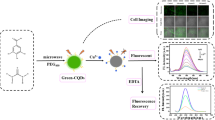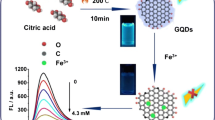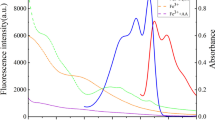Abstract
Trace ferric ion (Fe3+) detection has attracted increasing attention as an essential and indispensable role in many physiological and pathological research. The green-emitting carbon quantum dots (Green-CQDs) were obtained through a green and facile one-step hydrothermal method for the specific recognition and trace detection of Fe3+ in this paper. The optimal excitation and emission wavelengths of the CQDs were 395 nm and 490 nm, respectively. The stokes shift was up to 95 nm, which can effectively reduce the background fluorescence interference. In addition, it also exhibited good water solubility, stability, and high biocompatibility. The fluorescence intensity of Green-CQDs was linearly related to the concentration of Fe3+ (range of 0–80 μmol/L), and the detection limit was as low as 59 nmol/L. These good properties were favorable and successful for Fe3+ detection in tap water, human serum samples and living cells. In addition, a fluorescence visual test paper (FP@CQDs) was prepared utilizing filter paper as carrier, which can quickly identify Fe3+ in real time, and is suitable for the visualization analysis of Fe3+ in environment. As an efficient nanoprobe, the Green-CQDs held great promise and bright prospects in practical application in prevention and early clinical diagnosis of Fe3+-associated diseases.








Similar content being viewed by others
Data Availability
Data will be made available on request.
References
Qi H, Teng M, Liu M, Liu S, Li J, Yu H, Teng C, Huang Z, Liu H, Shao Q, Umar A, Ding T, Gao Q, Guo Z. Biomass-derived nitrogen-doped carbon quantum dots: highly selective fluorescent probe for detecting Fe3+ ions and tetracyclines. J Colloid Interface Sci. 2019;539:332–41.
Li S, Li Y, Cao J, Zhu J, Fan L, Li X. Sulfur-doped graphene quantum dots as a novel fluorescent probe for highly selective and sensitive detection of Fe3+. Anal Chem. 2014;86(20):10201–7.
Morales M, Xue X. Targeting iron metabolism in cancer therapy. Theranostics. 2021;11(17):8412–29.
Muñoz M, Acheson AG, Auerbach M, Besser M, Habler O, Kehlet H, Liumbruno GM, Lasocki S, Meybohm P, Rao Baikady R, Richards T, Shander A, So-Osman C, Spahn DR, Klein AA. International consensus statement on the peri-operative management of anaemia and iron deficiency. Anaesthesia. 2017;72(2):233–47.
Sahoo SK, Sharma D, Bera RK, Crisponi G, Callan JF. Iron(III) selective molecular and supramolecular fluorescent probes. Chem Soc Rev. 2012;41(21):7195–227.
Coates TD. Physiology and pathophysiology of iron in hemoglobin-associated diseases. Free Radic Biol Med. 2014;72:23–40.
Dugan C, MacLean B, Cabolis K, Abeysiri S, Khong A, Sajic M, Richards T. The misogyny of iron deficiency. Anaesthesia. 2021;76(Suppl 4):56–62.
Powers JM, Buchanan GR. Disorders of iron metabolism: new diagnostic and treatment approaches to iron deficiency. Hematol Oncol Clin N Am. 2019;33(3):393–408.
Bloomer SA, Brown KE. Iron-induced liver injury: a critical reappraisal. Int J Mol Sci. 2019;20(9):2132.
He J, Fang A, Yu S, Shen X, Li K. Dietary nonheme, heme, and total iron intake and the risk of diabetes in adults: results from the china health and nutrition survey. Diabetes Care. 2020;43(4):776–84.
Torti SV, Manz DH, Paul BT, Blanchette-Farra N, Torti FM. Iron and cancer. Annu Rev Nutr. 2018;38:97–125.
Belaidi AA, Bush AI. Iron neurochemistry in Alzheimer’s disease and Parkinson’s disease: targets for therapeutics. J Neurochem. 2016;139(Suppl 1):179–97.
Li J, Wang Q, Guo Z, Ma H, Zhang Y, Wang B, Bin D, Wei Q. Highly selective fluorescent chemosensor for detection of Fe3+ based on Fe3O4@ZnO. Sci Rep. 2016;6(1):23558.
Zhang B, Liu W, Wu X, Zhu J, Hu W, El Jaouhari A, Liu X. Facile preparation of fluorescent carbon dots from glutathione and l-tryptophan for sensitive and selective off/on detection of Fe3+ ions in serum and their bioimaging application. ACS Omega. 2022;7(9):7853–64.
Zhang Q, Sun Y, Liu M, Liu Y. Selective detection of Fe3+ ions based on fluorescence MXene quantum dots via a mechanism integrating electron transfer and inner filter effect. Nanoscale. 2020;12(3):1826–32.
Wypijewska A, Galazka-Friedman J, Bauminger ER, Wszolek ZK, Schweitzer KJ, Dickson DW, Jaklewicz A, Elbaum D, Friedman A. Iron and reactive oxygen species activity in Parkinsonian substantia nigra. Parkinsonism Relat Disord. 2010;16(5):329–33.
Ma ZM, Wu XS, Zheng DD, Wei JY, **e YN, Shi YB, Huang K, Zhang XM, Liu J. Well-aligned TiO2 nanotube arrays with Ag nanoparticles for highly efficient detection of Fe3+ ion. Nanoscale Res Lett. 2019;14(1):49.
Ninwong B, Ratnarathorn N, Henry CS, Mace CR, Dungchai W. Dual sample preconcentration for simultaneous quantification of metal ions using electrochemical and colorimetric assays. ACS Sens. 2020;5(12):3999–4008.
Sadak O, Sundramoorthy AK, Gunasekaran S. Highly selective colorimetric and electrochemical sensing of iron (III) using nile red functionalized graphene film. Biosens Bioelectron. 2017;89(Pt 1):430–6.
Michalke B. Review about powerful combinations of advanced and hyphenated sample introduction techniques with inductively coupled plasma-mass spectrometry (ICP-MS) for elucidating trace element species in pathologic conditions on a molecular level. Int J Mol Sci. 2022;23(11):6109.
Kindra LR, Eggers CJ, Liu AT, Mendoza K, Mendoza J, Klein Myers AR, Penner RM. Lithographically patterned PEDOT nanowires for the detection of iron(III) with nanomolar sensitivity. Anal Chem. 2015;87(22):11492–500.
Zhuang Q, Zeng C, Mu Y, Zhang T, Yi G, Wang Y. Lead(II)-triggered aggregation-induced emission enhancement of adenosine-stabilized gold nanoclusters for enhancing photoluminescence detection of nabam—disodium ethylenebis(dithiocarbamate). Chem Eng J. 2023;470: 144113.
Zhang T, Zhuang Q, Wang Y. Copper–carbon dot aerogel: a high-performance mimetic peroxidase and its application for versatile colorimetric bioassays. Chem Commun. 2022;58(93):12955–8.
Zeng C, Mu Y, Cao W, Zhuang Q, Wang Y. Water-soluble photoluminescent adenosine-functionalized gold nanoclusters as highly sensitive and selective receptors for riboflavin detection in rat brain. Anal Chem. 2023;95(2):1671–9.
Tao Z, Yi G, Zeng C, Zhuang Q, Wang Y. Ultrasensitive detection of silver(I) ions based on water-soluble micellized phosphorescent silver nanoclusters co-protected by 1,3-benzenedithiol and triphenylphosphine. Sens Actuat B Chem. 2022;369: 132382.
Mu Y, Zhuang Q, Huang S, Hu M, Wang Y, Ni Y. Adenine-stabilized carbon dots for highly sensitive and selective sensing of copper(II) ions and cell imaging. Spectrochim Acta A Mol Biomol Spectrosc. 2020;239: 118531.
Zhuang Q, Cao W, Ni Y, Wang Y. Synthesis-identification integration: one-pot hydrothermal preparation of fluorescent nitrogen-doped carbon nanodots for differentiating nucleobases with the aid of multivariate chemometrics analysis. Talanta. 2018;185:491–8.
Ye Q, Dai T, Shen J, Xu Q, Hu X, Shu Y. Incorporation of fluorescent carbon quantum dots into metal–organic frameworks with peroxidase-mimicking activity for high-performance ratiometric fluorescent biosensing. J Anal Test. 2023;7:16–24.
Chen S, Chen C, Wang J, Luo F, Guo L, Qiu B, Lin Z. A bright nitrogen-doped-carbon-dots based fluorescent biosensor for selective detection of copper ions. J Anal Test. 2021;5:84–92.
Luo K, Luo W, Liang Z, Li Y, Kang X, Wu Y, Wen Y. Self-do** synthesis of iodine–carbon quantum dots for sensitive detection of Fe(III) and cellular imaging. New J Chem. 2022;46:19283.
Rong M, Wang D, Li Y, Zhang Y, Huang H, Liu R, Deng X. Green-emitting carbon dots as fluorescent probe for nitrite detection. J Anal Test. 2021;5:51–9.
Tian YL, Ji YY, Zou X, Chen QM, Zhang SL, Gong ZJ. N, P Co-doped carbon dots as multifunctional fluorescence nano-sensor for sensitive and selective detection of Cr(VI) and ascorbic acid. J Anal Test. 2022;6:335–45.
Cai R, **ao L, Liu M, Du F, Wang Z. Recent advances in functional carbon quantum dots for antitumour. Int J Nanomed. 2021;16:7195–229.
Khan ME, Mohammad A, Yoon T. State-of-the-art developments in carbon quantum dots (CQDs): photo-catalysis, bio-imaging, and bio-sensing applications. Chemosphere. 2022;302: 134815.
Zhang TT, Chen ZH, Shi GY, Zhang M. Eu3+-doped bovine serum albumin-derived carbon dots for ratiometric fluorescent detection of tetracycline. J Anal Test. 2022;6:365–73.
Yadav PK, Upadhyay RK, Kumar D, Bano D, Chandra S, Jit S, Hasan SH. Synthesis of green fluorescent carbon quantum dots from the latex of Ficus benghalensis for the detection of tyrosine and fabrication of Schottky barrier diode. New J Chem. 2021;45(28):12549–56.
Zhao L, Wang Y, Zhao X, Deng Y, **a Y. Facile synthesis of nitrogen-doped carbon quantum dots with chitosan for fluorescent detection of Fe3+. Polymers (Basel). 2019;11(11):1731.
Nagaraj M, Ramalingam S, Murugan C, Aldawood S, ** JO, Choi I, Kim M. Detection of Fe3+ ions in aqueous environment using fluorescent carbon quantum dots synthesized from endosperm of Borassus flabellifer. Environ Res. 2022;212(Pt B): 113273.
Ge G, Li L, Chen M, Wu X, Yang Y, Wang D, Zuo S, Zeng Z, **ong W, Guo C. Green synthesis of nitrogen-doped carbon dots from fresh tea leaves for selective Fe3+ ions detection and cellular imaging. Nanomaterials (Basel). 2022;12(6):986.
Ye S, Zhang M, Guo J, Song J, Zeng P, Qu J, Chen Y, Li H. Facile synthesis of green fluorescent carbon dots and their application to Fe3+ detection in aqueous solutions. Nanomaterials (Basel). 2022;12(9):1487.
Chen M, Zhai J, An Y, Li Y, Zheng Y, Tian H, Shi R, He X, Liu C, Lin X. Solvent-free pyrolysis strategy for the preparation of biomass carbon dots for the selective detection of Fe3+ ions. Front Chem. 2022;10: 940398.
Wang L, Li W, Yin L, Liu Y, Wu MJSA. Full-color fluorescent carbon quantum dots. Sci Adv. 2020;6(40): eabb6772.
Li H, Su D, Gao H, Yan X, Kong D, ** R, Liu X, Wang C, Lu G. Design of red emissive carbon dots: robust performance for analytical applications in pesticide monitoring. Anal Chem. 2020;92(4):3198–205.
Kang S, Wang H, Guo M, Zhang L, Chen M, Jiang S, Li X, Jiang S. Ethylene-vinyl alcohol copolymer-montmorillonite multilayer barrier film coated with mulberry anthocyanin for freshness monitoring. J Agric Food Chem. 2018;66(50):13268–76.
Li D, Li W, Zhang H, Zhang X, Zhuang J, Liu Y, Hu C, Lei B. Far-red carbon dots as efficient light-harvesting agents for enhanced photosynthesis. ACS Appl Mater Interfaces. 2020;12(18):21009–19.
Zan M, Li C, Zhu D, Rao L, Meng QF, Chen B, **e W, Qie X, Li L, Zeng X, Li Y, Dong WF, Liu W. A novel “on-off-on” fluorescence assay for the discriminative detection of Cu(II) and l-cysteine based on red-emissive Si-CDs and cellular imaging applications. J Mater Chem B. 2020;8(5):919–27.
Gao W, Song H, Wang X, Liu X, Pang X, Zhou Y, Gao B, Peng X. Carbon dots with red emission for sensing of Pt2+, Au3+, and Pd2+ and their bioapplications in vitro and in vivo. ACS Appl Mater Interfaces. 2018;10(1):1147–54.
Li DY, Wang SP, Azad F, Su SC. Single-step synthesis of polychromatic carbon quantum dots for macroscopic detection of Hg2+. Ecotoxicol Environ Saf. 2020;190: 110141.
Choudhury A, Kim J-H, Sinha Mahapatra S, Yang K-S, Yang D-J. Nitrogen-enriched porous carbon nanofiber mat as efficient flexible electrode material for supercapacitors. ACS Sustain Chem Eng. 2017;5(3):2109–18.
Wu Y, Cao L, Zan M, Hou Z, Ge M, Dong WF, Li L. Iron and nitrogen-co-doped carbon quantum dots for the sensitive and selective detection of hematin and ferric ions and cell imaging. Analyst. 2021;146(15):4954–63.
Shangguan J, Huang J, He D, He X, Wang K, Ye R, Yang X, Qing T, Tang J. Highly Fe3+-selective fluorescent nanoprobe based on ultrabright N/P codoped carbon dots and its application in biological samples. Anal Chem. 2017;89(14):7477–84.
Geng Y, Chen L, Wan Q, Lian C, Han Y, Wang Y, Zhang C, Huang L, Zhao H, Sun X, He H. A novel [1,2,4]triazolo[1,5-a]pyrimidine derivative as a fluorescence probe for specific detection of Fe3+ ions and application in cell imaging. Anal Chim Acta. 2021;1187: 339168.
Sagar P, Gupta GK, Srivastava M, Srivastava A, Srivastava SK. Tagetes erecta as an organic precursor: synthesis of highly fluorescent CQDs for the micromolar tracing of ferric ions in human blood serum. RSC Adv. 2021;11(32):19924–34.
Atchudan R, Edison T, Aseer KR, Perumal S, Karthik N, Lee YR. Highly fluorescent nitrogen-doped carbon dots derived from phyllanthus acidus utilized as a fluorescent probe for label-free selective detection of Fe3+ ions, live cell imaging and fluorescent ink. Biosens Bioelectron. 2018;99:303–11.
Xu J, Wang Y, Sun L, Qi Q, Zhao X. Chitosan and κ-carrageenan-derived nitrogen and sulfur co-doped carbon dots “on-off-on” fluorescent probe for sequential detection of Fe3+ and ascorbic acid. Int J Biol Macromol. 2021;191:1221–7.
Wang Y, Liu F, Pu C, Tong Z, Wang M, Wang J. Galactose-imidazole mediated dual-targeting fluorescent probe for detecting Fe3+ in the lysosomes of hepatocytes: design, synthesis and evaluation. Biosens Bioelectron. 2022;204: 114083.
Zhu L, Shen D, Liu Q, Wu C, Gu S. Sustainable synthesis of bright green fluorescent carbon quantum dots from lignin for highly sensitive detection of Fe3+ ions. Appl Surf Sci. 2021;565: 150526.
Wang Q, Wang Z, Pu Z, Wang Y, Li M. Lanthanum-doped carbon quantum dots (La-CQDs) for detection of Fe3+ in colorimetric test paper and information anti-counterfeiting. Opt Mater. 2023;137: 113630.
Tony Elizabeth A, James E, Infant Jesan L, Denis Arockiaraj S, Edwin VA. Green synthesis of value-added nitrogen doped carbon quantum dots from Crescentia cujete fruit waste for selective sensing of Fe3+ ions in aqueous medium. Inorg Chem Commun. 2023;149: 110427.
Sunil S, Mandal BK. Synthesis of fluorescent carbon quantum dots doped graphitic carbon nitride and its application as Fe3+ sensors. J Cluster Sci. 2023;34(5):2591–607.
Zhang L, Li B, Zhou Y, Wu Y, Le T, Sun Q. Green synthesis of cow milk-derived carbon quantum dots and application for Fe3+ detection. J Sol-Gel Sci Technol. 2023;106(1):173–85.
Wang K, Chen J, Li H, Zhang M, Liao Q, Wang L, Zhang Y, Niu X. A fluorescent probe for selective detection of Fe3+ by using a self-assembled nitrogen-doped carbon quantum dots-3,4,9,10-perylenetetracarboxylic acid composite. Ionics. 2021;27(11):4907–16.
Ji Y, Wang M, Yang Z, Qiu H, Kou S, Padhiar MA, Bhatti AS, Gaponenko NV. Pressure-driven transformation of CsPbBrI2 nanoparticles into stable nanosheets in solution through self-assembly. J Phys Chem Lett. 2020;11(22):9862–8.
**e Z, Sun X, Jiao J, **n X. Ionic liquid-functionalized carbon quantum dots as fluorescent probes for sensitive and selective detection of iron ion and ascorbic acid. Colloid Surface A. 2017;529:38–44.
Zhang H, Chen Y, Liang M, Xu L, Qi S, Chen H, Chen X. Solid-phase synthesis of highly fluorescent nitrogen-doped carbon dots for sensitive and selective probing ferric ions in living cells. Anal Chem. 2014;86(19):9846–52.
Liu W, Diao H, Chang H, Wang H, Li T, Wei W. Green synthesis of carbon dots from rose-heart radish and application for Fe3+ detection and cell imaging. Sens Actuat B Chem. 2017;241:190–8.
Zulfajri M, Gedda G, Chang CJ, Chang YP, Huang GG. Cranberry beans derived carbon dots as a potential fluorescence sensor for selective detection of Fe3+ ions in aqueous solution. ACS Omega. 2019;4(13):15382–92.
Acknowledgements
We appreciatively acknowledge fiscal assistance from Foundation of Shaanxi Provincial Natural Science Basic Research Project, China (2019JQ-461), China Postdoctoral Science Foundation on the 61st Project (2017M613190), and Shaanxi Provincial Education Department (16JK1770).
Author information
Authors and Affiliations
Contributions
XZ: investigation, visualization. WW: conceptualization, data curation, writing—original draft. LG and YZ: resources, validation. DL and HC: visualization, validation. LZ: writing—review and editing. SH: funding acquisition, supervision, writing—review and editing.
Corresponding authors
Ethics declarations
Conflict of Interest
The authors declare that they have no known competing financial interests or personal relationships that could have appeared to influence the work reported in this paper.
Supplementary Information
Below is the link to the electronic supplementary material.
About this article
Cite this article
Zhang, X., Wang, W., Guan, L. et al. Preparation of a Novel Green Fluorescent Carbon Quantum Dots and Application in Fe3+-Specific Detection in Biological System. J. Anal. Test. 8, 40–51 (2024). https://doi.org/10.1007/s41664-023-00283-x
Received:
Accepted:
Published:
Issue Date:
DOI: https://doi.org/10.1007/s41664-023-00283-x




